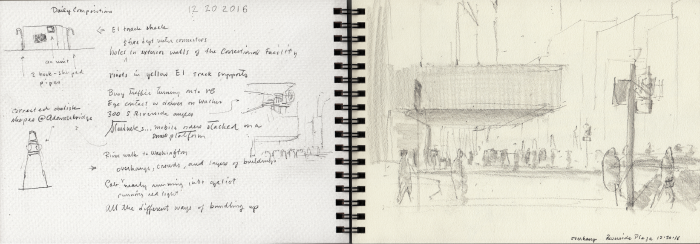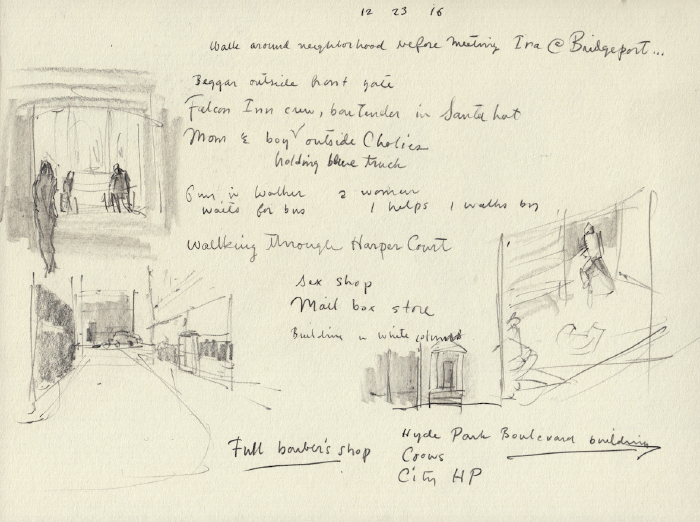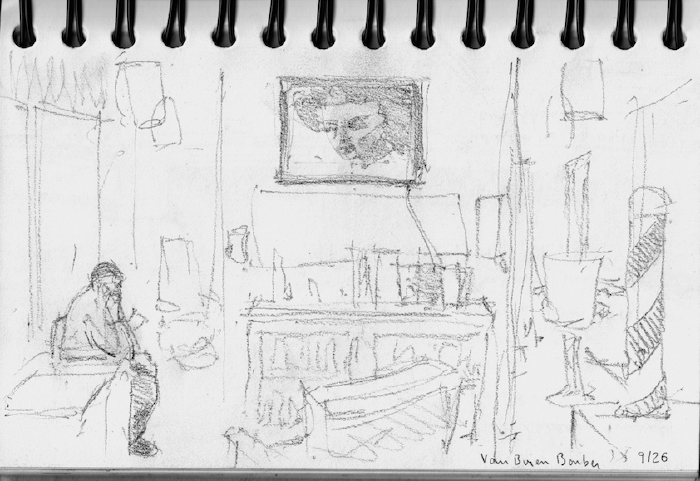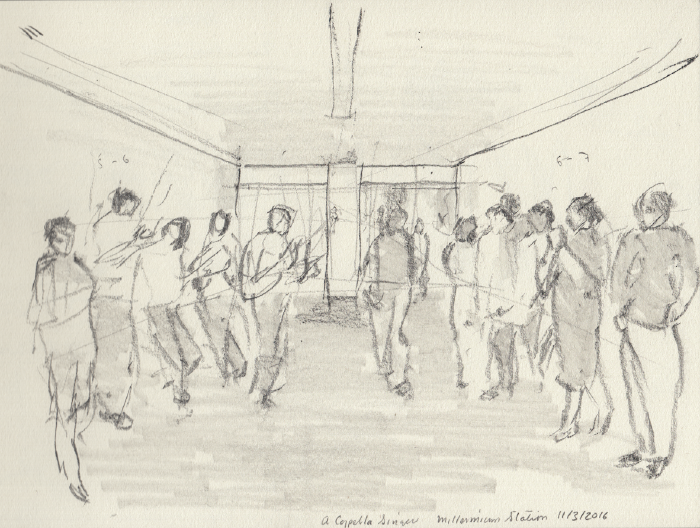Daily Memory Drawings
art .....
Later: Repainting
Earlier: Questions to Ask

Every day for the past three months I have drawn some scene or event that I saw that day, purely from memory.
Usually this is something I saw on the way to work, or, if I'm home that day, something I saw when out for a run or a walk somewhere in the neighborhood.
Since I usually make the drawing at the end of the day, several hours will have passed by the time I get around to recording what I saw. To keep this purely about memory (with bits of invention as needed), I don't allow myself any notes or photo references. As a result, while going about my day, I need to work extra hard to have a chance to remember the things I see. Sometimes I'll stop on the street and spend extra time looking at something, perhaps making little drawing gestures in the air to build a little muscle memory about the shapes, and no doubt drawing a stare or two from passersby. Other times if I've seen something transitory while walking I'll look down at the sidewalk and go over the scene in my mind with minimal distraction from new visual inputs.
Throughout the day, if I think of it, I'll try to recall one or two things I've seen to increase the chance of recall later.
When I sit down to draw, I first make a list of all the things I can remember seeing, sometimes accompanied by small thumbnail sketches.

Then I choose one thing as the subject of a larger, 15- to 20-minute drawing, usually 6"x8".


While the drawings are usually not particularly good (and definitely not "finished" by my usual standards), doing this exercise religiously for awhile has had a few noticeable effects:
- The exercise forces me to get out of the house at least once per day, no matter my schedule or the weather.
- The drawings seem to be getting a little better, and a little more complex, on average.
- I can remember more at the end of the day, often enough to fill two pages of notes and drawings.
- Things I see throughout the day are more vivid and can pack more emotional punch. I feel a stronger connection to my surroundings, the city of Chicago in particular.
- Imagining or inventing things, coming up with ideas for drawings or compositions, seems easier.
I have been appreciating the last two items especially.
I don't have a great memory, so this exercise sometimes feels impossible, and involves a fair amount of staring off into space. Like writing down dreams, however, once I get going, I tend to remember more than I thought I would.
This activity is, with a minor variation or two, the "Daily Composition" exercise proposed by Kimon Nicolaïdes in The Natural Way to Draw. Without giving much explanation, he asserts,
No other exercise in the book is more important than this one. These compositions do not have to be right. They can be all wrong. The important thing is to do them — three hundred and sixty-five of them between today and this date next year. It will be helpful if you keep this up for a year, and it will be twice as helpful if you keep it up for two years. The really serious student will make a quick composition every day for the rest of his life despite everything else he has to do.
I first read about this exercise in the 1980s. How I wish I had followed that advice consistently since then! Nevertheless, when I go back and look at old sketchbooks and discover my occasional Daily Compositions, no matter how bad the drawings, I do feel the strings of memory vibrating strongly.
I think this exercise is hard to do consistently because, at first, there isn't much to work with… nothing to copy from. A newcomer to the exercise will struggle when all he or she has to work with is a few wispy clouds of memory and spotty knowledge of lighting, anatomy, weather, architecture, costume, etc. But working on one's weak spots is a great way to improve. In particular, when I go back to a spot I've tried to draw, I notice many things I missed the first time. It's fun to re-draw those things, armed with the extra knowledge.
It's also nice to have a fairly clear idea of what to draw at least once per day, without worrying about making it anything complicated or clever. (Generally one of the day's memories stands out clearly as the best subject for a drawing.)
All art considerations aside, this exercises exposes the vast extent of my ignorance of the simplest things I encounter every day. The process of learning to notice my environment more feels like a healthy (albeit upstream) direction to take in a world where constant distraction by one's smartphone has become the norm.
Since starting this exercise I've looked around for other references to working from memory. It seems that the practice was more common in the 19th Century. Degas, in particular, and Whistler used memory extensively in their work. More on this, perhaps, in later posts. In any case, it seems to me that the practice is not given its due in contemporary teaching and discourse (I don't remember any discussion of it in art school).
What things that you see every day are worthy of your repeated attention and study… or even memorization?

Later: Repainting
Earlier: Questions to Ask